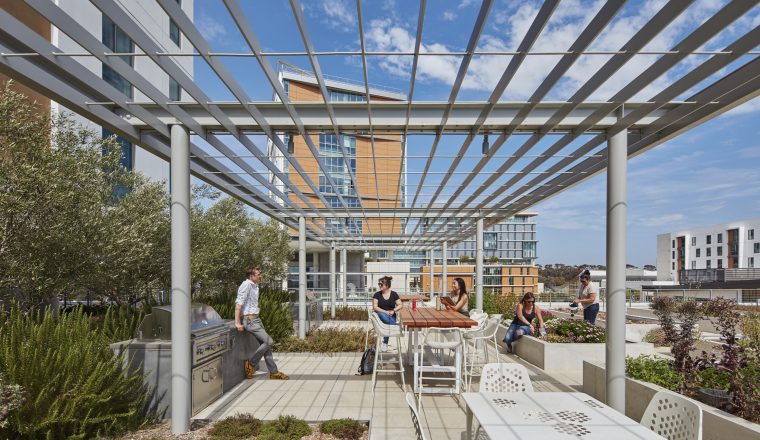2022 AIA CA DESIGN AWARDS
Special Commendation: Design for Discovery
UCSD North Torrey Pines Living and Learning Neighborhood
Architect: HKS Architects, Inc. and Safdie Rabines Architects
Project Location: San Diego, California
Photographer: Tom Harris
10-acre, 1,600,000 SF NTPLLN brings to life UC San Diego’s vision for a vibrant community that blends residential, academic, commercial and cultural programming into one neighborhood. NTPLLN has 2,048 beds, a dining hall, a market, a craft center, a 650-seat lecture hall, underground parking, restaurants and office space for faulty, administration, and staff. Designed to achieve LEED platinum, the project has been established as a Living Lab where on-going research projects explore interface of higher student outcomes and wellness.
“The plan is quite compelling and created a lovely experience for pedestrians in a new the neighborhood.” – 2022 Design Awards Jury
Design for Integration
UC San Diego’s newest campus for Sixth college, the design team has designed a dynamic mixed-use community guided by research-based and wellness-focused concepts to encourage better socialization and elevate student performance. The relationship between wellness, academic success, and belonging underpins the design of every room, common area, and pathway on campus. Maximized natural ventilation, daylighting and access to outdoors, the campus provided meaningful resiliency when NTPLLN opened during the pandemic.
Design for Equitable Communities
The project’s collaborative development process, coupled with its socially and environmentally sensitive design, sets a new benchmark for communities facing overpopulation, density concerns, and climate change. The design-build team and UC San Diego shared core values of improving higher education, creating better access to housing, and promoting health and sustainability on campus. NTPLLN demonstrates how intentional collaboration and outcome-driven design are powerful tools in building a more equitable, sustainable future.
Design for Ecosystems
NTPLLN features an extensive network of green outdoor spaces with native plants and other plants appropriate for La Jolla’s distinct microclimates. The Neighborhood’s accessible roof terraces are immersive landscapes with trees and shrubs that offer biophilic benefits and sensory connections to the surrounding site. The landscaped roofs reduce rainwater runoff that would be harmful to a thriving ecosystem and are also designed to cool buildings and the air around them through evapotranspiration, exemplifying a mutually beneficial relationship between the built and natural environments. The project minimizes light trespass, reduces sky-glow, and improves nighttime visibility for better human and animal well-being.
Design for Water
Connecting to and utilizing San Diego’s ever-expanding purple pipe system for recycled water became a key water resilience strategy for the project. NTPLLN will solely use the recycled water supply and infrastructure for irrigation needs as they arise. Using this available resource ensures that water supplies are not depleted and manages operational costs for UC San Diego as potable water becomes scarcer and rising costs. Drought-tolerant vegetation helps decrease overall consumption and offset municipal potable water use that has a higher associated water quality carbon intensity. NTPLLN exceeds LEED minimum requirements by 47%, saving over 17 million gallons annually.
Design for Economy
The mixed-use campus generates economic and social value for the entire UC San Diego community. The construction cost was $326/sf and Triple Bottom Line Cost Benefit Analysis (TBL-CBA) illuminated a net present value of $578/sf over a 30-year time frame. The project includes equitable shared spaces that yielded a 20% building efficiency ratio improvement. The central utility plant reduces operational costs by 80% and natural ventilation eliminates mechanical ducts, pipework and equipment from residential spaces. With fewer systems in the above-ceiling space, building heights were reduced, providing first-cost savings and 1.3% total embodied carbon reductions (958-MT-CO2e) on materials and systems.
Design for Energy
NTPLLN achieves a 30% energy improvement over CEC 2016 Title 24 as well as a 70% energy reduction through the AIA 2030 Commitment with high-performance passive design and systems informed by life-cycle energy modeling. Optimized building massing and orientation leverage the local microclimate to augment natural cross-ventilation design and provide a healthier, more productive environment. Integrated trickle vents and negatively pressurized continuous exhaust systems increase air volumes by more than 30%. Photovoltaic arrays and a modular micro-anerobic digester directly reduce dependency on fossil fuels and aid UCSD’s commitment to generating clean, cost-effective renewable energy, reducing operating costs by approximately 9%.
Design for Well-being
NTPLLN incorporates holistic, evidence-based strategies to improve physical, mental, and social wellbeing. Leveraging Point-of-Decision Design, a framework by the Center for Advanced Design Research and Evaluation (CADRE) that encourages well-planned ecological schemes and cues to influence how individuals decide on how to participate in activities, the design team sought to make healthy choices accessible, affordable, and appealing. Each building features healthy materials selections, extensive daylighting, scenic coastal views, and connections to nature, which facilitate mental and physical wellness. Communal areas such as a rooftop vegetable garden and community kitchens on each residence floor encourage healthy eating, physical activity, and socializing.
Design for Resources
NTPLLN’s sustainable building materials are exposed cast-in-place concrete structures and wood panels with limited additional finishes and substrates. Structural post-tension floor slabs reduced thickness and rebar use, increased resistance to soil deflection, and minimized building heights, leading to less clad surface area and savings on materials costs and embodied carbon. 85.91% of construction waste was diverted from landfills. The team’s early project model, allowed trade partners to pre-fabricate and quickly install low-waste components on-site, reducing the construction’s carbon footprint. The anaerobic digester diverts organic waste to the landfill and creates valuable resources such as liquid fertilizer for community gardens.
Design for Change
NTPLLN’s design emphasizes resilience and changes in the environment and human behavior. All buildings are designed for passive survivability.
- As a premiere scientific research institution and one of the first universities to launch a Climate Action Plan, UC San Diego is a leader in climate studies and education. NTPLLN’s design emphasizes resilience and potential changes in the environment and human behavior. All
buildings are designed for passive survivability. Informed by predictive future climate modeling (IPCC AR5, RCP 8.5, 95% warming percentile), the team designed natural ventilation systems to maintain indoor thermal comfort per ASHRAE standards in the face of a more extreme climate
future. As natural disasters and increasing storms threaten California, the design includes bioswales, drought resistive vegetation and landscaped areas that capture, infiltrate, and treat storm water runoff for 90% of the average annual rainfall in La Jolla. - The university’s first microanaerobic digester, located by the main dining hall, generates on-site renewable energy and organic fertilizer from food waste, establishing a precedent for wider adoption throughout the university.
- A three-story underground parking structure, which includes Parksmart Gold targeted energy efficiency solutions such as emissions sensors and natural ventilation, has generous lightwells and increased structural loads, allowing for future conversion to additional academic space.
- Since the majority of the power utilized on the main campus of UC San Diego is self-generated with CHP (natural gas and biogas), and renewable energy (fuel cell and photovoltaics), the campus can operate in island mode independently of the local utility grid. Though NTPLLN is not located along a major fault line, the threat of earthquakes is ever present, and the entire project meets California’s rigorous building codes as well as UC San Diego standards to accommodate life safety and continued operations in the face of seismic events.
- NTPLLN is participating in San Diego Gas & Electric (SDG&E) Savings By Design commercial new construction program to enhance the project’s energy performance potential.
- The siting and massing of Housing buildings are intentional design measures to balance access to daylighting, reduce solar gains and promote natural ventilation. Given the favorable and unique climate conditions in San Diego, over 70% of Housing building area is naturally ventilated which is an alternative passive measure to using energy intensive mechanical ventilation and cooling. These naturally ventilated areas improve cognitive functions from increased volumes of outside air.
- The integration of Photovoltaic (PV) panels directly reduces the dependency of fossil fuels thereby reducing carbon emissions from power generation. This contributes to UCSD’s commitment to generating clean sustainable renewable energy by expanding their solar power generation network.
- To encourage the development of grid-source, renewable energy technologies, NTPLLN will solely purchase power from green power sources and providers.
Design for Discovery
Once completed in 2020, students will move from their existing buildings to the new North Torrey Pines Living and Learning Neighborhood (NTPLLN), which provides the rare opportunity for a longitudinal research study in real-life settings. This new community will serve as a “living lab” where a culture of continuous discovery, iterative improvement and disruptive innovation is encouraged within a framework of research rigor and meaningful practice. This reflects the ethos of an RO1 research university and in many ways it exemplifies the feedback loop between discovery and integration as an ongoing cycle so that capital investments on campus can be long-term investments for research & education and active means to improve human and planetary health. To advance this agenda, the Detailed Project Program for NTPLLN was designed to include a piece of original research as a deliverable. The design team has partnered with UC San Diego to develop a pre- and post-research study assessing student mental and physical health before and after moving to the new campus. With the study, there exists an opportunity to narrow down some key hypothesis from the “living lab” and test them in a new neuro-architecture test lab. By measuring participants’ physiological and neurological responses to the new built environment, data can be obtained to support (or not) some design concepts. The research is currently underway.
In addition, measurement and verification (M&V) will take place in compliance with LEED requirements to ensure that the operation of the buildings align with the project’s design intent. The extensive metering on the project will be integrated into a forward-facing energy kiosk to inform building occupants and visitors of real-time building performance and reduction in carbon emissions. Referencing the Chancellor’s vision for the University and goals identified in the 2008 UC San Diego Climate Action Plan, NTPLLN is implementing a multidisciplinary immersion course that utilizes the built environment to educate and prepare UC San Diego students to become green building leaders and sustainability-focused citizens. In the course, students are engaging with design professionals who are designing and delivering NTPLLN. It is providing hands-on experience on a real project that not only helps students learn skills and knowledge, but also teaches them the skills needed to succeed in the workplace such as project management, teamwork, confidence and empowerment. This pilot-course has since become a for credit course at UC San Diego, a first of its kind focused on Green Building Design and Practices.


